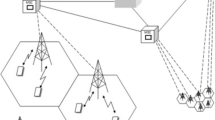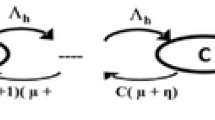Abstract
This paper evaluates call admission control algorithms for a cellular or microcellular system. Algorithms are evaluated based on two Quality of Service (QoS) metrics: the new call blocking probability, which is the probability that a new call is denied access to the system, and the forced-termination probability, which is the probability that a call that has been admitted will be terminated prior to the call's completion. Three novel algorithms are presented: the Weighted Sum Scheme, the Probability Index Scheme, and the Hybrid Control Scheme. The weighted sum scheme uses the weighted sum of the number of calls underway in various cells when making the admission decision. The probability index scheme computes a probability index, which reflects the forced-termination probability of a new call arrival, and admits those calls with low probability indexes. The hybrid control scheme combines these two approaches. These novel algorithms are compared with three known algorithms: the Reservation Scheme in which a specific number of channels are reserved in each cell for handoffs, the Linear Weighting Scheme in which the admission decision depends on the total number of calls underway in a group of cells, and the Distributed Admission Control Scheme in which the admission decision depends on the projected overload probabilities in the cell at which the new call arrives and adjacent cells. We show that the Hybrid Control Scheme yields the best performance, particularly during periods when load differs from the expected level. We also show that the simple Reservation Scheme performs remarkably well, often superior to more complex schemes that have been proposed.
Similar content being viewed by others
References
A.S. Acampora and M. Naghshineh, An architecture and methodology for mobile-executed handoff in cellular ATM networks, IEEE Journal on Selected Areas in Communications 12(8) (October 1994) 1365–1374.
A.S. Acampora and M. Naghshineh, Control and Quality-of-Service provisioning in high-speed microcellular networks, IEEE Personal Communications (Second Quarter 1994) 36–43.
A. Aljadhai and T.F. Znati, A predictive bandwidth allocation scheme for multimedia wireless networks, in: Proceedings of IEEE/ACM/SCS Conference on Communication Networks and Distributed Systems Modeling and Simulation, Phoenix (January 1997) pp. 95–100.
C. Chen, Linear System Theory and Design (Harcourt Brace College Publishers, Orlando, 1984).
A. Hills and D.B. Johnson, Seamless access to multiple wireless data networks. A wireless data network infrastructure at Carnegie Mellon University, IEEE Personal Communications 3(1) (February 1996) 56–63.
D. Hong and S. Rappaport, Traffic modelling and performance analysis for cellular mobile radio telephone systems with prioritized and nonprioritized handoffs procedures, IEEE Transactions on Vehicular Technology 35(3) (August 1986) 77–92.
D.A. Levine, I.F. Akyildiz and M. Naghshineh, A resource estimation and call admission algorithm for wireless multimedia networks using the shadow cluster concept, IEEE/ACM Transactions on Networking 5(1) (February 1997) 1–12.
M. Naghshineh and M. Schwartz, Distributed call admission control in mobile/wireless networks, IEEE Journal on Selected Areas in Communications 14(4) (May 1994) 711–717.
J.M. Peha, Spectrum management policy options, IEEE Communications Surveys 1(1) (Fourth Quarter 1998).
J.M. Peha and F.A. Tobagi, Cost-based scheduling and dropping algorithms to support integrated services, IEEE Transactions on Communications 44(2) (February 1996) 192–202.
E.C. Posner and R. Guerin, Traffic policies in cellular radio that minimize blocking of handoff calls, in: Proceedings of ITC-11, Kyoto, Japan (September 1985) pp. 153–163.
S. Rappaport, The multiple-call hand-off problem in high capacity cellular communications systems, IEEE Transactions on Vehicular Technology 40(3) (August 1991) 546–557.
H. Salgado, M. Sirbu and J.M. Peha, A narrow band approach to efficient PCS spectrum sharing through decentralized DCA access policies, IEEE Personal Communications 4(1) (February 1997) 24–34.
D.P. Satapathy and J.M. Peha, Spectrum sharing without licensing: Opportunities and dangers, in: Interconnection and the Internet: Selected Papers From the 1996 Telecommunications Policy Research Conference, eds. G.L. Rosston and D. Waterman, Lawrence Erlbaum Associates, Mahwah, NJ (1997) pp. 49–75.
D.P. Satapathy and J.M. Peha, Etiquette modifications for unlicensed spectrum: Approach and impact, in: Proc. IEEE Vehicular Technology Conference, Ottawa, Canada (May 1998) pp. 272–276.
A. Sutivong, Call admission control algorithms for a cellular system: Proposal and comparison, Masters Thesis, Carnegie Mellon University, Pennsylvania (1996).
A. Yener and C. Rose, Genetic algorithms applied to cellular call admission: Local policies, IEEE Transactions on Vehicular Technology 49(1) (February 1997) 72–79.
Author information
Authors and Affiliations
Rights and permissions
About this article
Cite this article
Peha, J.M., Sutivong, A. Admission Control Algorithms for Cellular Systems. Wireless Networks 7, 117–125 (2001). https://doi.org/10.1023/A:1016629421079
Issue Date:
DOI: https://doi.org/10.1023/A:1016629421079




